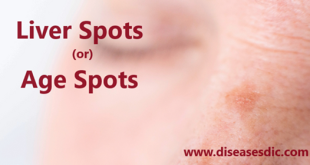What is Pressure Ulcers?
Pressure Ulcers – also called bedsores ulcers and decubitus ulcers – are injuries to skin and underlying tissue resulting from prolonged pressure on the skin. Bedsores most often develop on skin that covers bony areas of the body, such as the heels, ankles, hips and tailbone.
People most at risk of bedsores have medical conditions that limit their ability to change positions or cause them to spend most of their time in a bed or chair.
Bedsores can develop over hours or days. Most sores heal with treatment, but some never heal completely. You can take steps to help prevent bedsores and help them heal.
Pathophysiology
Many factors contribute to the development of pressure ulcers, but pressure leading to ischemia and necrosis is the final common pathway.
Pressure ulcers
- Result from constant pressure sufficient to impair local blood flow to soft tissue for an extended period.
- External pressure must be greater than the arterial capillary pressure (32 mm Hg) to impair inflow for an extended time
- Greater than the venous capillary closing pressure (8-12 mm Hg) to impede the return of flow for an extended time.
- Tissues are capable of withstanding enormous pressures for brief periods, but prolonged exposure to pressures just slightly above capillary filling pressure initiates a downward spiral toward tissue necrosis and ulceration.
- The superficial dermis can tolerate ischemia for 2 to 8 hours before breakdown occurs.
- Deeper muscle, connective tissue, and fat tissues tolerate pressures for 2 hours or less (probably because of its increased need for oxygen and higher metabolic requirements).
- Often there is significant damage to underlying tissues while the epidermis and dermis remain intact.
- By the time ulceration is present through the skin level, significant damage of underlying muscle may already have occurred, making the overall shape of the ulcer an inverted cone.
- Friction caused by skin rubbing against surfaces like clothing or bedding can also lead to the development of ulcers by contributing to breaks in the superficial layers of the skin.
- Moisture can cause ulcers and worsens existing ulcers via tissue breakdown and maceration.
Causes
Bedsores are caused by pressure against the skin that limits blood flow to the skin. Limited movement can make skin vulnerable to damage and lead to development of bedsores.
Three primary contributing factors for bedsores are:
- Pressure. Constant pressure on any part of your body can lessen the blood flow to tissues. Blood flow is essential for delivering oxygen and other nutrients to tissues. Without these essential nutrients, skin and nearby tissues are damaged and might eventually die.
For people with limited mobility, this kind of pressure tends to happen in areas that aren’t well padded with muscle or fat and that lie over a bone, such as the spine, tailbone, shoulder blades, hips, heels and elbows.
- Friction. Friction occurs when the skin rubs against clothing or bedding. It can make fragile skin more vulnerable to injury, especially if the skin is also moist.
- Shear. Shear occurs when two surfaces move in the opposite direction. For example, when a bed is elevated at the head, you can slide down in bed. As the tailbone moves down, the skin over the bone might stay in place — essentially pulling in the opposite direction.
Risk factors
The following can increase the chances that sores develop:
- Being unable to move unaided
- Older age, as the skin becomes thinner and more fragile
- Incontinence, which increases the risk of skin damage and infection
- A low or high body mass index, or BMI, either of which can increase pressure
- A low body weight, which leads to less padding around the bones
- A condition, such as diabetes, that reduces feelings of pain
- Prolonged wound healing, as can also happen with diabetes
- Poor blood circulation
- Reduced mental awareness
Symptoms of pressure ulcers
Pressure ulcers can affect any part of the body that’s put under pressure. They’re most common on bony parts of the body, such as the heels, elbows, hips and base of the spine.
They often develop gradually, but can sometimes form in a few hours.
Early symptoms
Early symptoms of a pressure ulcer include:
- Part of the skin becoming discoloured – people with pale skin tend to get red patches, while people with dark skin tend to get purple or blue patches
- Discoloured patches not turning white when pressed
- A patch of skin that feels warm, spongy or hard
- Pain or itchiness in the affected area
A doctor or nurse may call a pressure ulcer at this stage a category 1 pressure ulcer.
Later symptoms
The skin may not be broken at first, but if the pressure ulcer gets worse, it can form:
- An open wound or blister – a category 2 pressure ulcer
- A deep wound that reaches the deeper layers of the skin – a category 3 pressure ulcer
- A very deep wound that may reach the muscle and bone – a category 4 pressure ulcer
Complications
Complications of pressure ulcers, some may be life-threatening, include:
- Cellulitis – Cellulitis is an infection of the skin and connected soft tissues. It can cause warmth, redness and swelling of the affected area. People with nerve damage often do not feel pain in the area affected by cellulitis.
- Bone and Joint Infections – An infection from a pressure sore can burrow into joints and bones. Joint infections (septic arthritis) can damage cartilage and tissue. Bone infections (osteomyelitis) can reduce the function of joints and limbs.
- Cancer – Long-term, non-healing wounds (Marjolin’s ulcers) can develop into a type of squamous cell carcinoma.
Diagnosis on admission to hospital
On admission to the acute or chronic care hospital all patients need a thorough skin assessment to determine if they may develop pressure ulcers or if they have symptoms of early pressure ulcers. (1-5)
Evaluation involves presence of previous ulcers, assessment of risk of pressure ulcer development.
Braden scale
Assessment of skin is done using various tools and the commonest one that is used is the Braden scale.
The scale rates all factors between 1 to 4, with the exception of friction and shear, which only has three points on its scale. The score is then added up.
This tool checks the following:
- Sensory parameters or sensation over the skin
- Moisture present of the skin
- Activity of the patient irrespective of his or her degree of mobility
- Mobility that assesses if the patient can change and control his or her body posture and position
- Nutritional assessment
- Assessment of friction forces and shearing forces over the affected skin.
The highest possible Braden score is 23. Patients with scores of 18 or less are considered to be at risk of pressure sores.
Special care is taken to prevent pressure sores and related skin changes among those at risk.
Assessment of those with pressure ulcers
In patients presenting with pressure ulcers the ulcer is documented using photographic evidence. Patient’s general health and nutritional status is assessed.
Mobility, previous pressure damage, level of consciousness, psychological factors etc. are also assessed.
The patient undergoes a routine blood test to detect infections, high blood sugar (diabetes), high blood cholesterol) and sometimes blood cultures to determine presence of infections.
Blood cultures are prescribed if there are signs of severe blood poisoning like fever, elevated white blood cell count, rigors, sweating and delirium.
Nutritional assessment is made by testing for serum albumin and haemoglobin (to detect anemia). A routine chest X ray is performed before any surgical treatment is chosen.
Evaluation of pressure ulcers
The ulcer is evaluated by looking at:
- Cause of the ulcer – diseases like diabetes, kidney disease anemia etc. are diagnosed
- The location of the ulcer is evaluated and all pressure spots are closely examined
- Dimensions of ulcer are marked by photographic evidence using a calibrated ruler
Evaluation of type of discharge and pus
Amount and type of discharge and pus is noted. This is assessed along with signs of infection.
A swap is used to take a sample of the pus or exudate and this is placed on a glass slide. This is evaluated after staining with appropriate dyes and examining under the microscope for presence of microorganisms.
The samples of the exudate is also used for culture in the laboratory and assessment of sensitivity to various antibiotics that may be used in therapy.
Presence of a track of pus or fistula or sinus is noted. This is usually a recurrent and bothersome condition that is difficult to treat without surgery.
Sepsis – Rarely will a skin ulcer lead to sepsis.
Staging of pressure ulcers
The ulcer is staged as per its depth. Staging does not depend on the total area of the ulcer. A stage I or II pressure ulcer may have a large surface area, but a stage III or IV is usually of relatively smaller diameter but of greater depth.
Stages are progressive and need regular assessment and early management.
- Stage 1 – There is a change in color of the skin that may turn redder or darker and may not blanch on application of pressure with a gloved finger. The skin feels warmer than that of the surrounding skin. In some cases the skin may appear normal and only an examination determines abnormality.
- Stage 2 – In this stage there is break in the outer epidermal layer of skin and some invasion within the next layer – the dermis. These show up as shallow craters, ulcers, blisters or abrasions. The blisters may be filled with a clear or cloudy fluid.
- Stage 3 – These extend into the subcutaneous tissue and gape as open wounds. Underlying bone, muscle, and tissues are visible but these structures are not affected. There may be formation of tunnels of damage in this stage.
- Stage 4 – These ulcers affect the underlying bones and muscles as well as joints, tendons and nerves.
Treatment of Pressure Ulcers
Treating pressure ulcers involves reducing pressure on the affected skin, caring for wounds, controlling pain, preventing infection and maintaining good nutrition.
Treatment team
Members of your care team might include:
- A primary care physician who oversees the treatment plan
- A physician or nurse specializing in wound care
- Nurses or medical assistants who provide both care and education for managing wounds
- A social worker who helps you or your family access resources and who addresses emotional concerns related to long-term recovery
- A physical therapist who helps with improving mobility
- An occupational therapist who helps to ensure appropriate seating surfaces
- A dietitian who monitors your nutritional needs and recommends a good diet
- A doctor who specializes in conditions of the skin (dermatologist)
- A neurosurgeon, vascular surgeon, orthopedic surgeon or plastic surgeon
Reducing pressure
The first step in treating a bedsore is reducing the pressure and friction that caused it. Strategies include:
- Repositioning. If you have a bedsore, turn and change your position often. How often you reposition depends on your condition and the quality of the surface you are on.
- Using support surfaces. Use a mattress, bed and special cushions that help you sit or lie in a way that protects vulnerable skin.
Cleaning and dressing wounds
Care for pressure ulcers depends on how deep the wound is. Generally, cleaning and dressing a wound includes the following:
- Cleaning. If the affected skin isn’t broken, wash it with a gentle cleanser and pat dry. Clean open sores with water or a saltwater (saline) solution each time the dressing is changed.
- Putting on a bandage. A bandage speeds healing by keeping the wound moist. It also creates a barrier against infection and keeps skin around it dry. Bandage choices include films, gauzes, gels, foams and treated coverings. You might need a combination of dressings.
Removing damaged tissue
To heal properly, wounds need to be free of damaged, dead or infected tissue. The doctor or nurse may remove damaged tissue (debride) by gently flushing the wound with water or cutting out damaged tissue.
Other interventions
Other interventions include:
- Drugs to control pain. Nonsteroidal anti-inflammatory drugs — such as ibuprofen (Advil, Motrin IB, others) and naproxen sodium (Aleve) — might reduce pain. These can be very helpful before or after repositioning and wound care. Topical pain medications also can be helpful during wound care.
- A healthy diet. Good nutrition promotes wound healing.
Surgery
A large bedsore that fails to heal might require surgery. One method of surgical repair is to use a pad of your muscle, skin or other tissue to cover the wound and cushion the affected bone (flap surgery).
Preventing Pressure Ulcers
It can be difficult to completely prevent pressure ulcers, but there are some things you or your care team can do to reduce the risk.
These include:
- Regularly changing your position – if you’re unable to change position yourself, a relative or carer will need to help you
- Checking your skin every day for early signs and symptoms of pressure ulcers – this will be done by your care team if you’re in a hospital or care home
- Having a healthy, balanced diet that contains enough protein and a good variety of vitamins and minerals – if you’re concerned about your diet or caring for someone whose diet may be poor, ask your GP or healthcare team for a referral to a dietitian
- Stopping smoking – smoking makes you more likely to get pressure ulcers because of the damage caused to blood circulation
If you’re in a hospital or care home, your healthcare team should be aware of the risk of developing pressure ulcers. They should carry out a risk assessment, monitor your skin and use preventative measures, such as regular repositioning.
If you’re recovering from illness or surgery at home, or you’re caring for someone confined to bed or a wheelchair, ask your GP for an assessment of the risk of developing pressure ulcers.
 Diseases Treatments Dictionary This is complete solution to read all diseases treatments Which covers Prevention, Causes, Symptoms, Medical Terms, Drugs, Prescription, Natural Remedies with cures and Treatments. Most of the common diseases were listed in names, split with categories.
Diseases Treatments Dictionary This is complete solution to read all diseases treatments Which covers Prevention, Causes, Symptoms, Medical Terms, Drugs, Prescription, Natural Remedies with cures and Treatments. Most of the common diseases were listed in names, split with categories.







